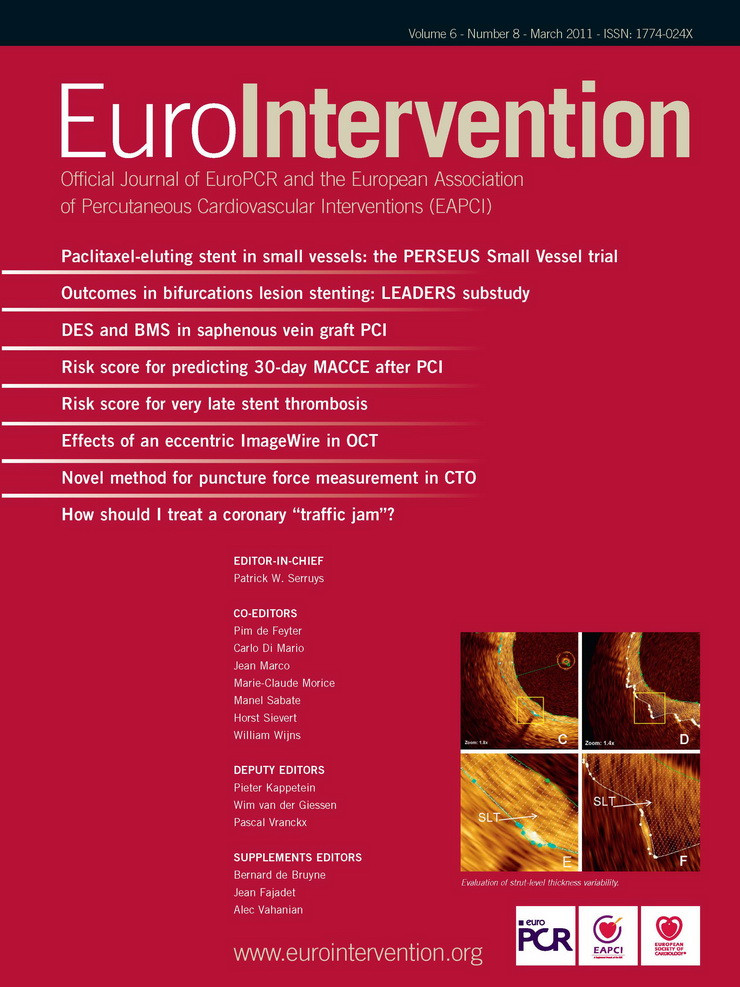Dear colleagues,
We are at that time of year when one season makes way for the next, when we participate in great meetings throughout the world, CIT in China, the ACC in the USA, and of course, EuroPCR here in Europe. These gathering are marked by an increasing amount of information, new techniques and breaking trials and EuroIntervention is committed to placing all this information into the perspective of your clinical practice, today, and tomorrow – helping you keep abreast of new developments and science.
One way we do this is through our “hands-on” sections such as Tools & Techniques or the challenging “How should I treat”, another way is by the focus we take with our clinical articles concentrating on a particular topic from several angles. In this issue, we take a figurative step back from our day-to-day practice, looking at something which, abstract at first, can be extremely useful, the notion and application of risk assessment tools.
I will not go into in detail here, we have an excellent editorial following my own, “a guide to interpreting and assessing the performance of prediction models”, but I do want to bring your attention to the four papers covering this topic that we present here in this current issue of EuroIntervention.
Beginning with the onset of the disease state, Jerome J. Federspiel et al discusses the “Risk-benefit trade-offs in revascularisation choices” expressing the wish that “ultimately, as more comprehensive data are available, risk-benefit determination can become increasingly personalised.” Hiroki Ito and colleagues takes a look at the short-term with a paper on “...predicting 30-day major adverse cardiac or cerebrovascular events...after PCI with with drug-eluting stents.” Kenneth W. Baran et al focuses on the long-term with their paper on a clinical “...risk score for very late stent thrombosis” also for patients with DES. We complete this special series of articles with an excellent statistical discussion from Australia by Ian R. Smith et al on “ graphical statistical process control (SPC) tools” in “Performance monitoring in interventional cardiology: application of statistical process control to a single-site database”. While it is true that it is might be unusual to see an article like this last one in EuroIntervention, our choice in publishing it is aimed at attracting a clinical oriented readership. The points discussed do have their clinical relevance, and these tools remain largely under-used by us. Again, we highly recommend the editorial by Vasim Farooq, Salvatore Brugaletta and Pascal Vranckx as an excellent overview of all four of these seminal articles.
Invasive imaging continues to attract our attention whether it be Nobuaki Suzuki and colleagues’ discussion of the “effects of an eccentric ImageWire in OCT” where they “designed a series of analyses, using coronary stents as a model, to investigate the influence of wire position on OCT-derived vascular images”, images which “enables characterisation of atherosclerosis and vascular response to injury,” but requires “image distortion” to “ensure optimal analysis”. We have an image in cardiology from Periklis A. Davlouros et al on OCT “features of late-stage recanalised coronary thrombi” and Giovanna Sarno and colleagues consider IVUS for optimal coronary stenting and whether “IVUS guided... PCIs may result in improved clinical outcomes when compared to the conventional angiography guided PCI.”
Our colleagues from Toronto, Canada, Amandeep Thind et al, offer us a “a novel method for measurement of proximal fibrous cap puncture force in chronic total occlusions: the effect of increasing age”. While in the experimental field, Cihan Simsek and colleagues presents the case for magnetic navigation for bifurcation stenting, concluding that “MPCI is associated with good angiographic-, fenestration- and procedural success rates in the treatment of coronary bifurcation lesions.”
Rounding out this issue we touch on the left main, first with an introductory T&T section on left main coronary artery PCI by Alfonso Ielasi and Alaide Chieffo followed by an interesting “How should I treat” from Luca Testa et al dealing with a coronary “traffic jam”: a case of a triple kissing balloon in distal LM trifurcation.
So we may be between seasons and meetings calender-wise, but here at EuroIntervention we are bursting with information for you and are pleased to have you join us on these pages.

